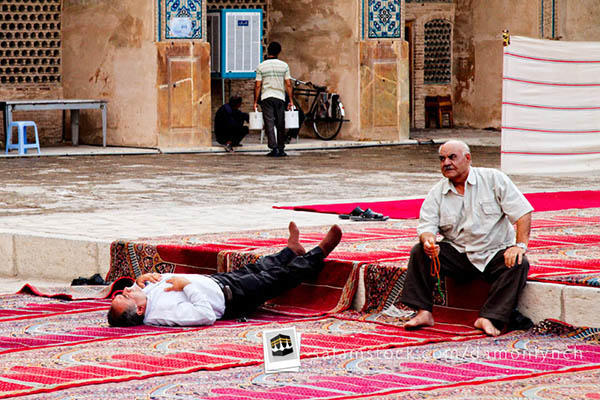
Dreams that Matter: Egyptian Landscapes of the Imagination
By Amira Mittermaier
University of California Press, 2010
“For years I wondered why dreams are often so dull when related,” William Burroughs once wrote, “and this morning I find the answer, which is very simple — like most answers, you have always known it: No context… like a stuffed animal set on the floor of a bank.”
Every Wednesday night from the years 2001 to 2003, millions of Egyptians would tune into Channel 3 on national television to watch Ru’a, a popular talk show in which audiences would intently listen in as callers would, in great detail, retell their dreams. With a guest psychologist by his side, the respected scholar Sheikh Hanafi, a theologian affiliated with the formidable Al Azhar institution, would interpret the stuff of the dreams. The program, which ran for fifty-seven episodes in total, had its ardent fans — one girl went as far as to take detailed notes every week and then re-dreamt dreams drawn from the show. Though lauded as a “fusion” of Islam and modern science, callers inevitably directed their requests to the sheikh and ignored the psychologist entirely (doubtless his Freudian interpretation would bring embarrassment).
And yet, a little over a year into its life, the show met a bitter end when a Saudi caller recounted a dream in which she saw the moon breastfeeding a boy. Though he later denied it, Sheikh Hanafi interpreted this strange vision to mean that the mahdi had been born, the savior in Sunni eschatology whose appearance indicates that the end of the world is nigh. Presumably fearing messianic rumblings, Al Azhar, the seat and voice of Sunni Islam, went into a frenzy, quickly issuing a decree prohibiting the broadcast of dreams to the masses. The Muslim Brotherhood, too, posted a fatwa online urging Muslims to distrust their dreams as sources of knowledge or guidance. In January 2003, Ru’a was wiped from the airwaves, and that was that.
Still, the light of the breastfeeding moon illuminated the way for the German-Egyptian anthropologist Amira Mittermaier, who recounts the story of the doomed television program in Dreams That Matter, a study of the place of dreams in contemporary Egyptian life. In her ethnography of dreaming in Cairo, we enter a culture of dream-telling and dream-interpretation enacted in homes and saint shrines, on Sufi broadcasts on satellite TV, and in cyber-dream websites run by sheikhs. Mittermaier surveys a city’s worth of narratives: dreams that offer romantic advice or identify partners for marriage, dreams that lead to the formation of new Egyptian political parties and construction projects, dreams of pets, of dead relatives, and of bodily functions, dreams featuring the Prophet Muhammad, and dreams incubated by sleeping in special positions. Her aim, ostensibly, is to construct an “anthropology of the imagination,” in which imagination is defined not as a faculty isolated in the brain but as a transcendent network of intermediary realms, an ontologically real space of the in-between where minds connect: between divine and human, living and dead, sleeping and waking, presence and absence, and illusion and reality. In her endeavor to look beyond the visible in Cairo, Mittermaier takes this in-between as her ethnographic object. Yet, it is, at times, a space the ethnographer herself gets tangled up in.
Not too far into the book, we learn the anthropologist’s research subjects begin to dream of her. And she, in turn, has dreams about them. One of her primary interlocutors, Sheikh Qusi has an active life in his followers’ dreams, which they record in a collective notebook with a photograph of the sheikh on the cover. This handwritten “Book of Visions” contains accounts of hundreds of dreams that he appeared in, from 1973 onwards. Mittermaier herself dreams that she gets into a fight with Sheikh Qusi — and then wakes up with two big scratches across her cheek. Awakening with dream-scars, she has herself slipped into the “Book of Visions” she came to Egypt to study in the first place, and into the intermediary realm between illusion and reality that she had objectively defined. Though she tells us she felt disturbed when she woke up that morning, Mittermaier doesn’t delve much deeper into her own implication in the ethnography of dreaming she constructs, missing out on certainly one of the most captivating dimensions of her own work.
Perhaps it was just too boring for Mittermaier to simply retell her interlocutors’ dreams in her book. Once she appeared in a sheikh’s dream wearing a school uniform. In another dream, she visited a research subject she had not yet met the night before their interview, enabling the woman to recognize her the next day. And yet, her participation raises age-old questions about the entanglement of ethnographers with their subjects, a question pushed to its extreme in the 1969 cult classic Keep the River on Your Right, a memoir and film about the anthropologist Tobias Schneebaum’s experience living in a remote jungle in Peru among the cannibalistic Arakmbut tribe. The ethnographer has sex with his subjects and, at one point, famously eats human flesh. It is true that entering subjects’ dreams isn’t as taboo as eating them for lunch, but still, her crossing into this intimate space raises questions about the ethnographer as director of the research and, indeed, its subject.
In the end, it is this unexpected narrative strand of Mittermaier’s own dream exploits in sleeping Cairo that makes the book worth reading. It is, too, in its approach and texture, a departure from most discussions about Cairo — or even cities for that matter — we encounter in the public sphere. Dreams that Matter is not straitjacketed as an exploration of underdevelopment, terrorism, gender, or politics, but rather, it is somehow all and none of these things at once. And for that reason alone, this somnambulist anthropologist’s exploration of Egyptian dream life is a unique, if not compelling, one.